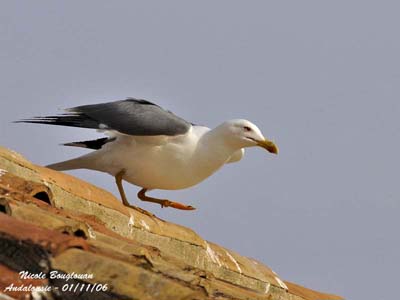
Lesser Black-backed Gull
Larus fuscus
Charadriiforme Order – Laridae Family
BIOMETRICS:
Length: 50-60 cm
Wingspan: 124-127 cm
Weight: 550-1200 g
LONGEVITY: up to 26 to 32 years
DESCRIPTION:
Lesser Black-backed Gull is a medium-sized gull with dark grey mantle and yellow legs. It is slightly smaller than Herring Gull (Larus argentatus).

Adult in breeding plumage has dark grey mantle and wings, and pure white underparts.
Wings show white edges and black tips with small white spots. In flight, we can see a white trailing edge. Tail is white.
Head is white with yellow bill. The lower mandible shows a red spot near the tip. Eyes are yellow with red eye-ring. Legs and feet are yellow.
Adult in winter plumage has paler grey mantle and wings. Head, nape, neck and upper breast are white, streaked with greyish-brown. The red spot of the bill is smaller and paler. Eyes lack the red eye-ring.
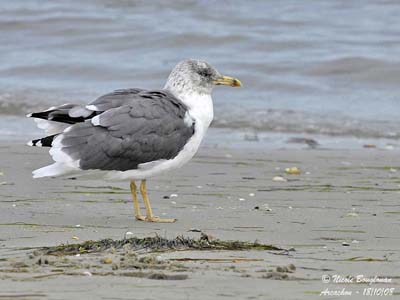
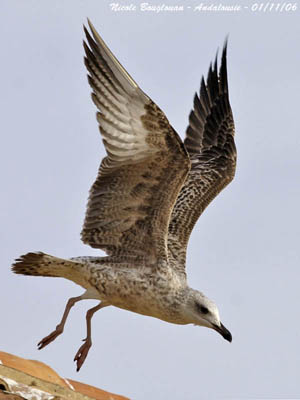
Both sexes are similar.
Juvenile and 1st winter are dark brown, darker than immature Herring Gull. The bill is black. Eyes are brown. Legs and feet are pinkish-brown.
Second winter shows whiter head and body. Some grey feathers appear on back and scapulars. Bill and legs start to resemble those of adults.
Young may breed at 4 years.
We can find four subspecies.
L.f. graellsii, from British Islands, Iceland, Faeroes, France and Spain. It has dark grey mantle.
L.f. fuscus, from Baltic Sea and E Scandinavia. It has jet black mantle.
L.f. intermedius from Netherlands, Denmark and S Norway. It has sooty black mantle.
L.f. heuglini from Siberia and Finland. It has dark grey mantle, very similar to L.f. graellsii and Larus fuscus, but the grey colour is variable.
VOICE: SOUNDS BY XENO-CANTO
Lesser Black-backed Gull calls loudly, giving an abrupt “ow-ow-ow-kyoww”. Its calls are deeper than those of the Herring Gull.
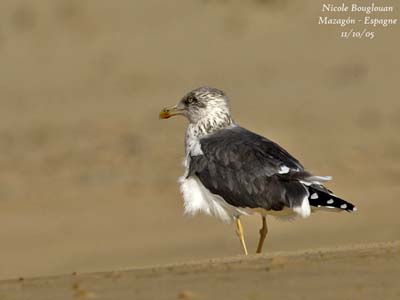
HABITAT:
Lesser Black-backed Gull frequents islands, lakes and coasts. It may be found both in coastal and inland habitats, and even in cultivated areas.
It breeds on coastal dunes, sandy coasts, but also with rock or grass, sea coasts, rocky islands, lake and river’s islands, locally on cliffs and buildings.
It winters in inshore and offshore coastal waters, and also in estuaries and harbours.
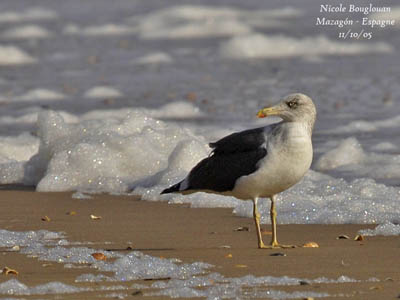
RANGE:
Lesser Black-backed Gull breeds on the Atlantic European coasts, but this migratory gull winters from the British islands to West Africa.
It is often seen on Atlantic coast of North America, maybe coming from Iceland.
BEHAVIOUR:
Lesser Black-backed Gull feeds on aquatic invertebrates, small fish, juvenile birds and eggs, rodents, berries and carrion, amphibians and reptiles on land.
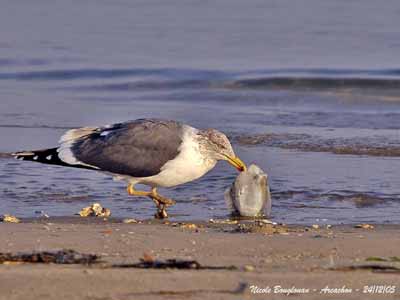
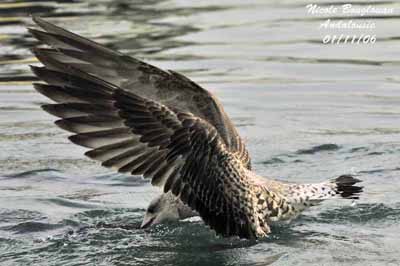
It feeds by “contact-dipping” and “surface-diving”. While flying, it plucks food items from the surface, or it may swim and pick up food, but also dip into water for catching them.
It also feeds on the ground by walking along and picking up live items, or taking carrion on the shore.
Lesser Black-backed Gull engages in piracy from its own species or others. It harasses and pursues the other bird until it regurgitates the food.
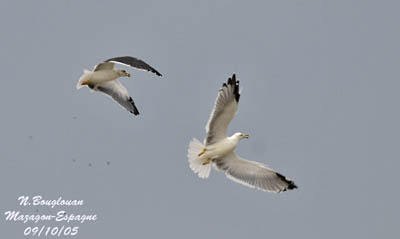
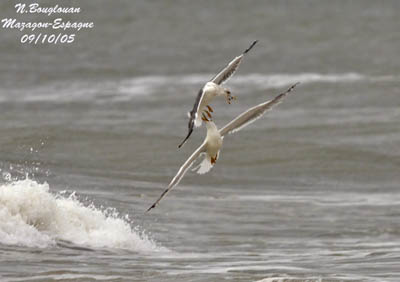
Pair bonds are often for life with high degree of fidelity year after year. They are territorial and defend strongly the nest-site.
During the breeding season, gulls are very vocal during the entire cycle. Displays are accompanied by calls. The typical “long call” is uttered by the gull while it raises the head and then, it gradually lowers it, giving a series of long notes. This display is often followed by “head-tosses”. The gull flings its head onto the back while it utters a plaintive note. Male also performs courtship feeding. Courtship displays increase little by little until the nest-site is chosen by both mates.
FLIGHT:
Lesser Black-backed Gull has an agile flight. It flies strongly and it is able to perform aerobatics for feeding or engaging in piracy from other birds.
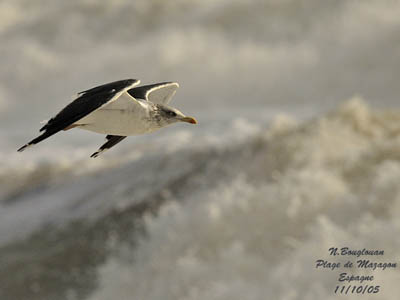
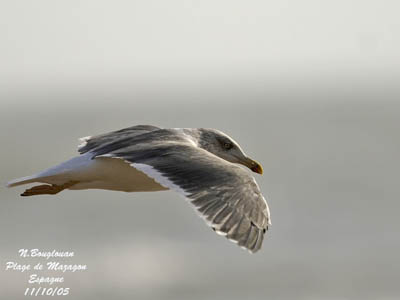
REPRODUCTION:
Breeding season occurs in spring. The birds arrive at colony in March.
The colony is established in varied kinds of shores such as grassy, rocky, dunes, cliff ledges, and even buildings. Lesser Black-backed Gull is often mixed with Herring Gulls. They prefer nest-sites with dense vegetation, sometimes under pine trees.
The nest is made with dry stems, grass, algae, lichen and feathers, and it is built by both adults.
Female lays 2-3 eggs, but number of eggs depends on food resources. Incubation lasts about 24 to 28 days, shared by both parents. Chicks are fed by both adults but mainly by female. They fledge about 30 to 40 days after hatching, but they are guarded by one or both parents until they fledge.
Usually, Lesser Black-backed Gull produces only one brood per year. Sometimes, they may replace a clutch if a nest-failure occurs.
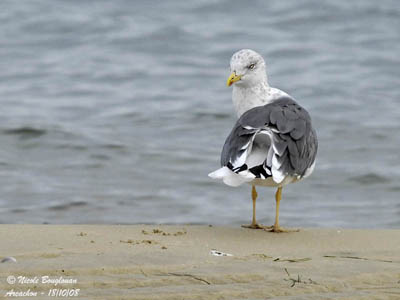
DIET:
Lesser Black-backed Gull feeds on small fishes, molluscs, worms, invertebrates, rodents, young birds and eggs of birds, some seeds and berries, and carrion.
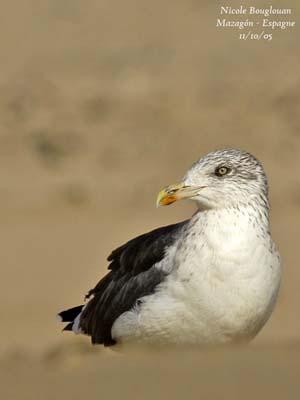
PROTECTION / THREATS / STATUS:
Lesser Black-backed Gull’s populations are stable, and even increasing since the 1940,s.
Herring Gull predation within the colonies may seriously affect the numbers. Changes in fishing practices and competitions with other species for food may involve some declines, mainly in Northern Europe.
However, this species is not globally threatened at this moment.
Fr: Goéland brun
All : Heringsmöwe
Esp: Gaviota Sombría
Ital: Zafferano
Nd: Kleine Mantelmeeuw
Russe: Клуша
Sd: Silltrut
Texte et photos de Nicole Bouglouan
Sources :
HANDBOOK OF THE BIRDS OF THE WORLD Volume 3 by Josep del Hoyo-Andrew Elliott-Jordi Sargatal - Lynx Edicions - ISBN : 8487334202
THE HANDBOOK OF BIRD IDENTIFICATION FOR EUROPE AND THE WESTERN PALEARCTIC by Mark Beaman, Steve Madge - C.Helm - ISBN: 0713639601
The Longevity List (Roland Staav)
Pájaros de España (JL Beamonte)
Wikipedia (Wikipedia, The Free Encyclopedia)